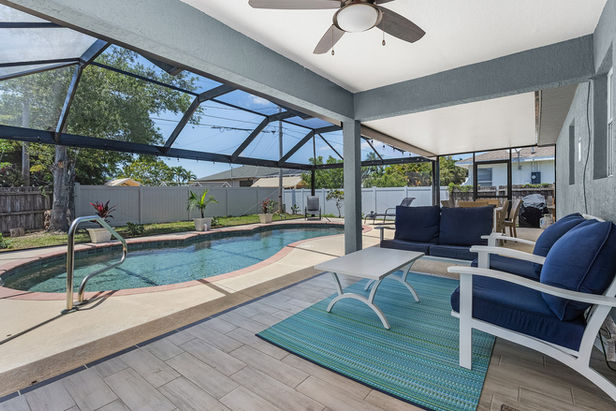
A checklist for visiting beaches near Cape Coral
Southwest Florida is known for having some of the country's best beaches. If you're visiting Cape Coral with your family and planning to visit the beautiful beaches, here is a checklist so you can make the most of your trip.
Feel free to jump around the page:
Packing Checklist -
(for guests of SerenityBNB, the Red items are located in the garage, Blue items in the laundry room & the Green items by the pool)
-
Bug Spray
-
Sun Screen
-
Beach Towels
-
Sandals or beach shoes
-
Book or other reading material
-
Cooler
-
Water or refreshments
-
Food & snacks
-
-
Umbrella or sun shade
-
Sunglasses
-
Beach Cart
-
Beach Chairs
-
Shelling scoop or net
-
Snorkeling gear
-
Pool noodles, floaties or other water toys
Note - While it is great to pack everything you need, the beaches surrounding Cape Coral can get extremely busy during the peak season (Jan-April).
If you want to get away from the crowds, you may think about packing light which will allow you to move farther down the beach and away from the crowds.
Animals & Insects
Your most common animal sightings will be:
- Mosquitoes & No See Ums (technically you won't see the no see ums)
- Dolphins
- Manatees
- Stingrays
- Turtles
No See Ums & Mosquitos
No-see-ums are tiny biting bugs that live near the water. They are not visible to the naked eye. Any steps you take to protect yourself from no-see-ums should also protect you from mosquitos.

Peak season for no-see-ums is March and April. Peak time to encounter no-see-ums is Dawn or Dusk.
The simpliest way to prevent getting bit by no-see-ums is wind. A fan or an afternoon breeze is usually sufficient to deter them.
However, there are days where the beach has little to no breeze. When this is the case, it is best to avoid swampy, wet or muddy soil.
You can try using: (specifically near elbows & ankles)
-
Long clothing
-
Eucalyptus oil
-
Mint oil
-
a citronella candle
-
Baby oil
-
Olive oil
-
traditional Deet bug spray
-
Sunscreen that contains bug spray

Potential remedies for no-see-um bites:
-
Wash the infected area with soap and hot water
-
Apply a stick of antiperspirant or deodorant to the infected area
-
Ice packs if there is swelling
-
Calamine or Hydrocortisone cremes
-
Rubbing alcohol - apply to the infected area
-
Baking Soda - mix with water and apply the paste
The Worst thing you can do is to scratch your bites. Scratching the bites can cause blisters & open wounds that can become infected.
Most commonly, bites can last up to two weeks.
Dolphins
If you see a line of beachgoers standing and pointing at the water, there's a good chance they're watching a dolphin.
Dolphin sightings are common on the beaches of Southwest Florida. Often times they come surprisingly close to shore and swimmers.

Short of taking a Dolphin Watching Tour, your best bet to catch dolphins is to get up early.
Late May through early August is commonly a good time of the year to see dolphins.
The early morning hours are when you are most likely to see a large group of dolphins feeding just offshore or cruising up & down the beaches.
You can also increase your chances of seeing dolphins by going where the fish are, such as Blinds Pass & Lighthouse Point.
Manatees
Manatees can be seen fairly frequently along the shores of the local islands. Most frequently you can see manatees in the warm waters where there are a lot of seagrasses.

During the winter, manatees seek refuge in the warmer waters of the canals. They can swim underwater for up to 20 minutes, but they typically come up for air every 3-5 minutes.
You can spot them underwater by the swirl patterns they create when they paddle their tail up and down. While they are very friendly and not harmful to humans, it is best not to touch them or get too close.
Stingrays
Stingrays are common in the waters around Florida and are frequently seen inshore from May through October.
Stingrays are often found buried in the sand just off local beaches. To avoid stepping on them (possibly resulting in a sting), beachgoers are encouraged to do the "Stingray Shuffle."

The "Stingray Shuffle" basically means shuffling or sliding your feet through the water as opposed to walking. Doing this creates vibrations that warn a stingray you are nearby. This can seem a bit awkward at first, but with enough time at the beach, you'll notice we're all awkward!
Water shoes or sandals will not prevent getting stung. Oftentimes stingray tails can penetrate shoes or hit you in exposed legs or ankles.
In the event that you do get stung, remove any bit of the barb from the wound (if possible). Wash the infected area, and soak in hot water (not cold) for 30-90 minutes to help relieve the pain and break down toxins from the venom. Seek medical attention.
Sea Turtles & Tortoises
With over 1,200 acres of conservation land on Sanibel & Captiva Islands, you stand a good chance of seeing turtles while you visit.
The most common sea turtle is the Loggerhead.
The most common tortoise (land turtle) is the Gopher Tortoise.

Loggerheads nest between October and March.
Gopher Tortoises can be seen along high & dry roadsides and along the interior of sandy coastal dunes.
Sea Turtles & Tortoises are under environmental threat so it is best to enjoy your view from a distance.
Weather & Traffic Conditions
In Southwest Florida, the summers are long, hot, wet & mostly cloudy with (mostly) daily rain showers.
Winters are short, comfortable & mostly clear weather. The joy that winters in Southwest Florida bring are offset by the traffic.
In peak travel season January through April, expect crowds & plenty of traffic delays.

Without a doubt, the best tip when visiting the beaches of Southwest Florida (especially during peak season), is to get an early start and get to the beach as early as possible.
Mornings bring some of the best opportunities for shelling and calm waters.
Afternoons often bring wavier water conditions & rain showers (especially during the summer). Like many tropical locations, rain showers are frequently brief & heavy. So be prepared.
Parking
Many of the local beaches have limited parking. To learn more specific parking details, visit our beaches page.
Make sure you plan ahead as most parking is paid by the hour.
Safety Considerations
Lightning is a fact of life in Southwest Florida and it is important not to take this safety concern lightly.
Most people are struck by lighting before it starts raining, or after it stops raining.
Remember, "when it roars, go indoors."
Your best bet is to find an enclosed shelter, or a hard-top vehicle with the windows rolled up.

Learn the 30-30 rule.
- 30 SECONDS: Count the seconds between seeing lighting and hearing thunder. If this time is less than 30 seconds, lighting is still a threat and you should seek shelter.
- 30 MINUTES: After the last lightning flash, wait 30 minutes before leaving your shelter. Roughly 50% of all lightning strikes happen after the storm passes.
Riptides & Rip Currents
A Rip tide is a current that pulls water through an inlet along a barrier beach.
A Rip current is a small & narrow current of water that cuts through waves, like a river going out to sea. Rip currents tend to be more unpredictable than rip tides.

Most beaches post safety warnings about rip tides & rip currents. Pay attention!
If you find yourself caught in a rip tide or current, the most important thing to do is to stay calm.
Swim parallel to the shore and try to gain the attention of people on shore for help.
Once you are outside of the rip tide or current (though likely much farther away from shore than comfortable), you can then start swimming back towards shore.
To check for current rip current conditions, check out the Current Rip Current Risk Here.


















